On October 26th, the "Sports Surface of Synthetic Materials for Primary and Secondary Schools" (Draft for Comment) was announced. This time, not only the standard content was published, but also the preparation instructions were published, including the revised background of the standard, revised principles and requirements, and physics. Performance and chemical properties, as well as comparisons with other relevant domestic and international standards, reflect the comprehensiveness, systemicity, scientificity, applicability and openness of the new standards.
Let's first take a look at the standard revision background and requirements.
1 Standard revision background
The development of the synthetic material surface layer of sports grounds in China began in 1978 and was developed by Baoding Synthetic Rubber Factory. In September 1979, the first indoor track and field stadium of Beijing Gymnasium was laid in Beijing, covering an area of ​​4,500 square meters. Since 1992, China's Guangdong, Jiangsu, Zhejiang and other economically developed provinces and cities have begun to build synthetic surface sports venues in primary and secondary schools. In 1997, Shanghai began to invest large-scale in the transformation of sports venues in primary and secondary schools. In 1999, Beijing also began to transform large and small schools in primary and secondary schools. China currently needs a large amount of land, laying about 3 million square meters per year. The number of plastic track manufacturers has increased from the original three to thousands. In the 21st century, as China's education field has begun to pay attention to the improvement of sports facilities, the annual sports grounds with various synthetic materials are more than 2.5 million square meters, making it the world's largest sports venue synthetic surface market.
With the progress of our society and the improvement of people's living standards, China's emphasis on physical education has been increasing. The synthetic sports surface sports venue has become one of the basic hardware of sports venues, universities, colleges and universities. Start laying a lot. In order to standardize the quality of the synthetic sports surface in the primary and secondary schools, the Department of Sports Health and Art Education of the Ministry of Education was responsible for drafting GB/T 19851.11-2005 "Sports Equipment and Sites for Primary and Secondary Schools Part 11: Surfaces for Synthetic Materials". The standard stipulates the technical requirements, quality standards and testing methods for laying surface layers of synthetic materials, and has detailed requirements for physical properties. Since the standard was released and implemented in 2005, the construction and use of synthetic sports surface sports venues have been guaranteed to a certain extent.
Since 2015, the plastic track has become the focus of parents and media attention. Many local students have symptoms such as nosebleeds, cough, dizziness, and rash. Even children have abnormal blood coagulation functions. Parents suspect that they are related to plastic runways. The request to eradicate the plastic track, the "poisonous runway" incident triggered a public opinion boom, and the community responded strongly.
In December 2015, the Shenzhen Institute of Metrology and Quality Inspection and the Guangdong Provincial Institute of Standardization conducted a sample survey of harmful gas release risks on 20 plastic sites and runways in four cities of Foshan, Shenzhen, Zhongshan and Huizhou in Guangdong Province. The survey found that The proportion of unreasonable risks in polyurethane plastic sites is as high as 25% (see "Monitoring Report on Volatile Hazardous Substances in Polyurethane Plastic Sites"). The reason is that in recent years, domestic school sports have flourished, the government and schools have increased their investment, and the market demand for synthetic sports surface sports venues has increased, which has led many bad enterprises to enter the market. The total number of plastic track production enterprises approved by the International Federation of Athletics Federations and the China Athletics Association is no more than dozens, but there are thousands of them actually doing, and nearly 3,000 were added in 2015. Some small “workshops†with no qualification, no technology, no production management and quality assurance have a market share of more than 50%, and the quality of products cannot be effectively guaranteed.
In order to regulate the market, ensure product quality, and protect students' physical health, the Ministry of Education has revised and revised the "Sports and Equipment for Sports and Equipment in the Elementary and Secondary Schools Part 11: Synthetic Materials Surface Sports Field", hoping to improve the standard content and clearly stipulate harmful substances in the surface of synthetic materials. The material limit requirement is to standardize the development order of the synthetic material surface sports field construction industry, promote the healthy and orderly development of the industry, and provide a safe and reliable sports environment for the majority of primary and middle school students in China.
In October 2016, the Ministry of Education submitted a revised application for the revision of the standard to the National Standards Committee, and applied for the establishment of a mandatory standard. At the same time, the standard name was changed to the “Sports Surface of Synthetic Materials for Primary and Secondary Schoolsâ€. On December 28, 2016, the National Standards Committee issued the mandatory national standard plan project “Synthetic material surface sports venues for primary and secondary schools†(plan number -Q-360).
2 Revision principles and requirements
2.1 The standard revision is based on the comprehensive results of science, technology and experience. In order to protect students' sports health, improve product quality and guide industry self-discipline, we will fully consider sports protection and durability on the basis of comprehensive, systematic, scientific and applicable. Requirements for usability, comfort and aesthetics, and environmental protection. Under the premise of meeting the requirements of use, optimize the allocation of social resources, provide guidance and basis for the design, construction and acceptance of outdoor synthetic materials surface sports venues for primary and secondary schools, so as to provide students with a healthy exercise environment, cultivate students' lifelong sports awareness and promote The sustainable development of school sports.
2.2 The principles of science, safety, environmental protection and sustainable development are revised and the following requirements are fully considered:
(1) Meet the requirements for sports use (in accordance with the requirements of the IAAF and China Association for the teaching/training/competition venue);
(2) Pay attention to sports performance and sports protection performance;
(3) Consider environmental impacts;
(4) The venue for competition/training needs to emphasize that the facility specifications meet the requirements for use;
(5) The teaching site focuses on sports protection performance, durability, and environmental protection;
(6) Reserve space for material science development and technological level improvement;
(7) Fully consider the safety of the site and limit the amount of harmful substances.
3 Main contents of the standard revision
This standard is applicable to outdoor sports flooring for synthetic materials. The main technical contents include paving requirements, thickness, physical and mechanical properties, harmful substances and test methods, etc., which emphasizes the increase of harmful substances in finished products and raw materials of synthetic materials. Limited indicator.
The following is a description of the development of physical performance indicators.
3.1 Synthetic material surface physical properties index
The main physical properties of the synthetic surface layer include: thickness, impact absorption, vertical deformation, anti-slip value, tensile strength, elongation at break, flame retardancy, and aging resistance.
3.1.1 Thickness of synthetic surface layer
(1) The thickness of the synthetic material surface layer refers to the total vertical distance between the surface of the synthetic material surface layer and its bottom surface. This thickness directly affects the elasticity of the site, and is closely related to the site's safety protection performance and motion performance. For young children, sports safety protection is especially important. In the original standard, the thickness of the surface layer was not clearly defined. The survey found that the ground layer of the synthetic material sports field laid by many schools is very thin, even less than 3mm. Such a site can not fully protect the sports safety of young people, and it is also very easy to wear and turtle. Cracked, the service life is also short.
Under the premise of the same material composition, the safety protection performance (shock absorption value) of the synthetic material surface layer has a close relationship with the thickness (see Table 1).
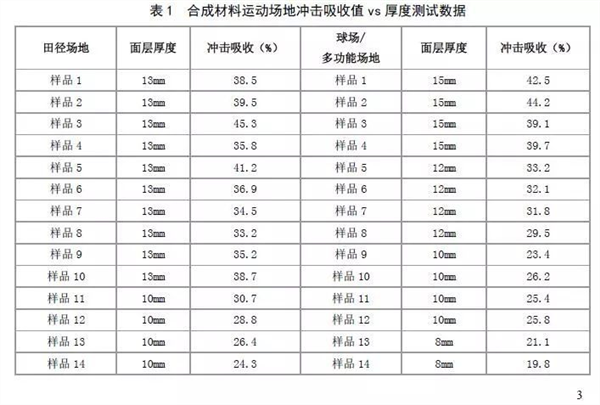
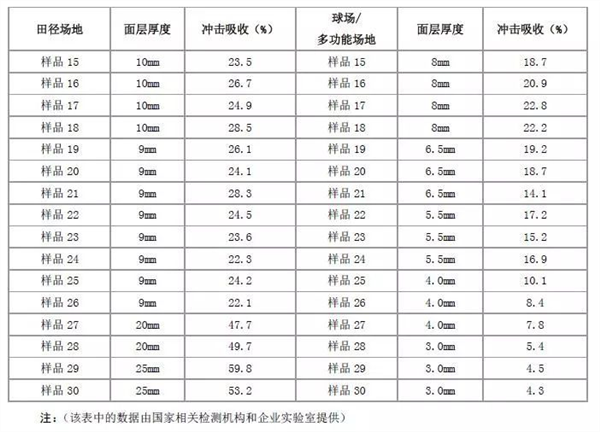
(2) In order to ensure that the synthetic material surface movement site can achieve the corresponding safety protection performance and durability performance, this standard combines the current national standards and international standards, and makes the following requirements for the surface layer thickness:
a) Track and field venues, the average thickness of the surface layer is required to be ≥13mm. This requirement is consistent with the relevant provisions of GB/T 14833-2011, GB/T 22517.6-2011 and EU standard EN 14877-2013 "Technical requirements for outdoor synthetic sports grounds". For the competition areas that need to be thickened such as high jump, long jump, etc., according to the "Track and Field Venue Standards Manual" (International Federation of Athletics Associations), the thickness requirements are set to ≥ 20 mm and ≥ 25 mm, respectively, in order to comply with the competition rules;
b) The ball field requires an average thickness of the surface layer ≥ 8mm. The EU standard EN 14877-2013 "Technical requirements for sports venues for outdoor synthetic materials" stipulates that the thickness of the ground layer of ball and multi-functional activity field is not less than 7mm. According to the test data of Table 1, the thickness of most synthetic sports surface layer products in China should reach 8mm. Above, the impact absorption value can reach more than 20%, in order to play a sufficient protective effect, so considering the impact absorption/thickness correspondence of the actual test and taking into account the higher frequency of use of the playground in domestic primary and secondary schools, the durability is Higher requirements, therefore increasing the thickness of 1mm on the basis of the EU standard EN 14877-2013, requiring the average thickness of the ball field ground layer ≥ 8mm;
c) For other venues, the average thickness of the surface layer is required to be ≥10mm. This requirement refers to the relevant provisions of the European Standard EN 14877-2013 "Technical Requirements for Outdoor Synthetic Material Sports Fields" and guarantees that the impact absorption value is ≥ 25%;
d) The thickness requirements for the surface layer of synthetic materials in this standard are shown in Table 2.
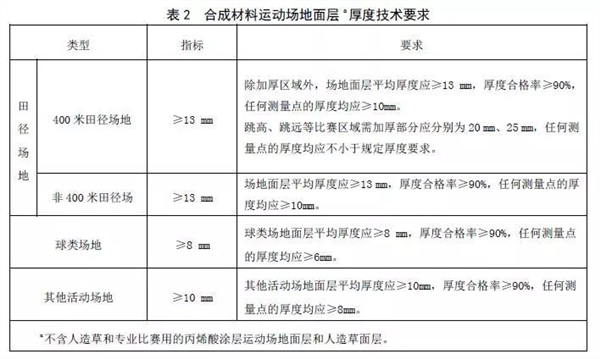
(3) The pair of surface layer thickness indicators of synthetic materials in this standard are shown in Table 3 for other relevant domestic standards.
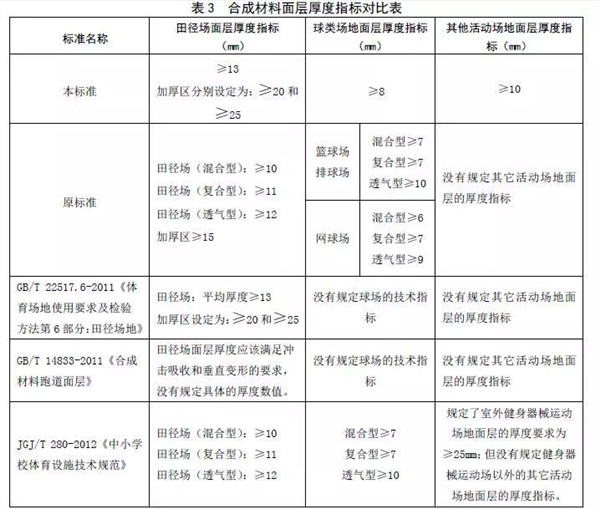
3.1.2 Impact absorption performance index of synthetic material surface layer
The impact absorption of the synthetic material surface layer is the slowing down performance of the synthetic material surface layer, and is the absorption performance of the potential energy when the synthetic material sports field is impacted, such as the moment when the shoes are in contact with the surface layer during running, the synthetic material movement The impact energy of the site is absorbed by the deformation, which embodies the protective effect of the synthetic sports field on the athletes. The greater the impact absorption value, the stronger the energy absorption capacity of the synthetic material sports field, and the better the protection of the vulnerable parts of the feet, ankles and knees of adolescents, suitable for long-term physical exercise without long-term chronicity. hurt.
Impact absorption is currently the internationally accepted core indicator for measuring the ground performance and cushioning performance of synthetic sports fields. It has corresponding regulations in IAAF, FIFA, FIBA ​​and European standards. The national standard GB/T 14833-2011 and GB/T 22517.6-2011 also have relevant regulations on the impact absorption of the synthetic material runway surface layer, requiring the impact absorption value to be 35% to 50%. In addition, GB 30228 is also for the sports field. Impulse attenuation performance is mandatory.
The original standard did not regulate the impact absorption. After discussion, the drafting group agreed that it is very necessary to increase the requirements for impact absorption to enhance the safety protection for young people during exercise. The specific numerical settings are as follows:
(1) When the average thickness of the ground layer of the synthetic material sports field is ≥13 mm, refer to the "Track and Field Venue Standards Manual" (International Federation of Athletics Associations), the European Union Standard EN 14877-2013 "Technical Requirements for Outdoor Synthetic Material Sports Fields", GB/ T 14833-2011, GB/T 22517.6-2011 and GB 30228-2012 stipulate that the impact absorption value in this standard is set to 35% to 50%, which is consistent with the above standard requirements;
(2) When the average thickness of the surface layer is ≥10 mm, refer to the European Standard EN 14877-2013 "Technical Requirements for Outdoor Synthetic Material Sports Fields" and the impact absorption value test data of Table 1. The impact absorption value in this standard is set to 25 %~50%, consistent with the relevant provisions of the European Union standard EN 14877-2013;
(3) When the average thickness of the surface layer is ≥8mm, combined with the EU standard EN 14877-2013 "Technical Requirements for Outdoor Synthetic Material Sports Field" and the impact absorption value test data of Table 1, the impact absorption value requirement in this standard is set to 20%. ~50%, compared with the impact absorption value required by the EU standard EN 14877-2013, the requirement is slightly relaxed, from the lower limit ≥25% to the lower limit ≥20%. Through on-site testing and observation at the basketball court, the impact absorption value is ≥20%, the site has better impact-resisting performance, and it has better sports safety protection for the young paint joints. (4) Table 4 is a comparison of the surface impact absorption properties of synthetic materials in this standard with other relevant domestic and international standards.
Table 4 Comparison of surface impact absorption performance indicators of synthetic materials
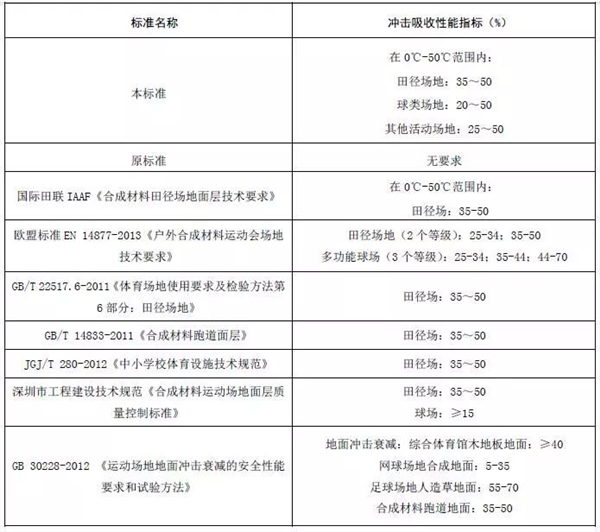
3.1.3 Vertical deformation of the composite surface
(1) Vertical deformation refers to the deformation of the ground in the vertical direction when the weight of 20 kg falls on the ground at a specified height. In the IAAF, FIFA, FIBA, European standards and relevant national standards, there are corresponding regulations. After discussion, the drafting team members agreed that it is very necessary to propose restrictions on vertical deformation. In general, the greater the impact absorption value of the site, the better the sports protection performance of the adolescents, but the vertical deformation value will also increase accordingly. Based on the comparison of the test data of 20 samples, it was found that when the impact absorption value was 40% or more, the corresponding vertical deformation exceeded 2.5 mm and nearly 3 mm (see Table 5).
The vertical deformation of the ground layer of the field should not be too small. The smaller the vertical deformation of the ground layer, the harder the surface of the field is, which is not conducive to the safety protection of athletes. The European Union Standard EN 14877-2013 "Technical Requirements for Outdoor Synthetic Material Sports Fields" stipulates that the upper limit of the vertical deformation value of the track and field ground level is 3mm. The national standard GB/T 14833-2011 and GB/T 22517.6-2011 stipulate that the track and field field ground layer is vertical. The lower limit of deformation is 0.6 mm, so the vertical deformation of this standard is specified as 0.6 mm to 3 mm with reference to the above EU standards and national standards, and combined with the actual test results (see Table 5).
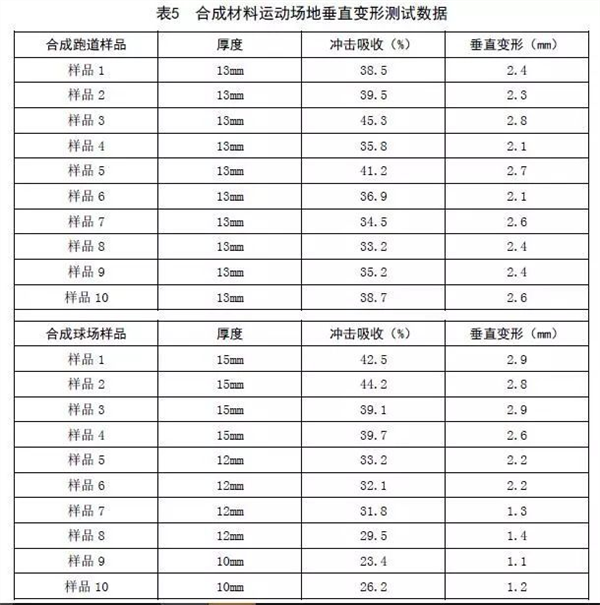
(2) Table 6 is the comparison of the vertical deformation value of the synthetic material surface layer with other relevant domestic and international standards in this standard.

3.1.4 Synthetic material surface anti-sliding value
(1) The anti-slip value of the synthetic material surface layer refers to the extent to which the ground layer of the synthetic material sports field absorbs energy through the sliding frictional resistance, that is, the frictional force that the surface layer can provide, which can measure the safety of the sports people from slipping and falling. The degree of protection. The national standard GB/T 14833-2011 and GB/T 22517.6-2011 require the anti-slip value of the synthetic material surface layer of the track and field site under wet conditions ≥47. The EU standard EN 14877-2013 "Technical requirements for outdoor synthetic materials sports grounds" requires outdoor synthesis. The ground layer of the material sports field has an anti-slip value of 55-110 under wet conditions and an anti-slip value of 80-110 under dry conditions.
The anti-slip value of the synthetic surface layer has two representations: the anti-slip value tested under wet conditions is the wet anti-slip value, and the anti-slip value tested under dry conditions is the dry anti-slip value; this standard considers Primary schools rarely carry out outdoor sports activities on rainy days, so the standard anti-sliding value of synthetic materials is indicated by the dry-testing anti-slip value.
As a sports ground for primary and secondary schools, it is necessary to ensure that the site has certain anti-skid requirements, but it is not the greater the anti-slip value of the sports venue. The upper limit should be set; refer to the EU standard EN 14877-2013 "Technical requirements for outdoor synthetic sports venues" The anti-slip value of the medium is 80-110 (dry test), and the anti-slip value of the surface layer of the synthetic material of this standard is set to 80-110 (dry test).
(2) Table 7 is the comparison of the anti-sliding value of the synthetic material surface layer in this standard with other relevant domestic and international standards.
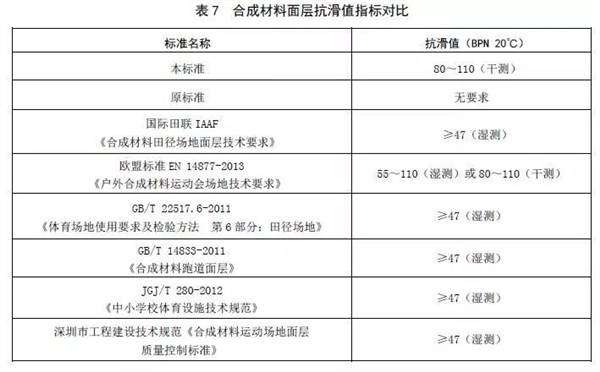
3.1.5 tensile strength and elongation at break of synthetic materials
(1) Tensile strength is the maximum tensile stress that a specimen receives until it breaks in a tensile test, and the elongation at break is the ratio of the displacement value of the material to the original length at the time of breaking. These two values ​​are indicators for measuring the strength and toughness of the material on the ground floor of the synthetic sports field. In terms of numerical setting, the current IAAF technical requirements, the European standard EN 14877-2013 and the national standard GB/T 14833-2011 and GB/ T 22517.6-2011 is consistent.
(2) Table 8 is a comparison of the tensile strength and elongation at break of the modified synthetic surface layer with relevant domestic and foreign standards.
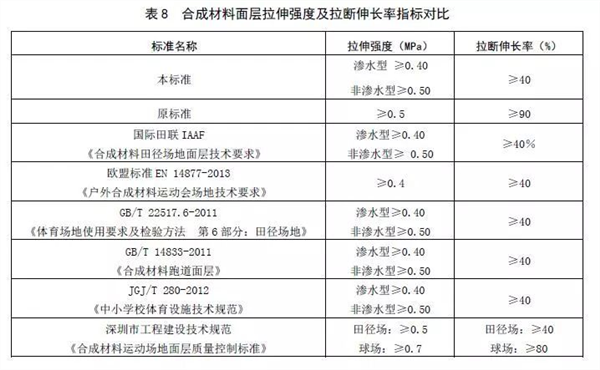
3.1.6 Flame retardant properties of synthetic materials
(1) Flame retardant property refers to the property of the ground layer of the synthetic material sports field to delay the spread of flame. The setting of this value in this standard is consistent with the current national standards GB/T 14833-2011 and GB/T 22517.6-2011.
(2) Table 9 is a comparison of the flame retardancy index of the surface layer of synthetic materials of this standard with relevant standards at home and abroad.
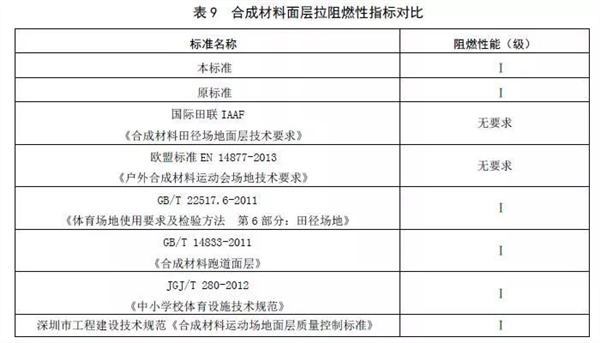
3.1.7 Synthetic material surface aging resistance
The aging resistance is the property of the sports ground layer material to delay the aging. In order to ensure the durability of the ground layer of the synthetic material sports field, it is proposed to increase the requirements in this standard: in addition to the ground layer of the acrylic coated sports field for professional competition, the synthetic material surface layer accelerates aging in the standard aging box for 168 hours, tensile strength and pulling The elongation at break shall meet the requirements of Table 2. For experimental methods of artificial climatic aging, GB/T 14833-2011, GB/T 22517.6-2011 and foreign related methods for determination of artificial climatic aging, most of the methods and methods of GB/T 16422.2-2006, cycle number 1 the same. It is found that the aging condition 168h mentioned in GB/T 14833 and GB/T 22517.6 cannot meet the total irradiation amount of 3000 MJ/m2 specified in the standard; if calculated according to the total irradiation amount, and according to the conditions specified in the standard The required test time is as high as 1515 hours, the detection period is long, and the main purpose of the total irradiation amount assessment is to evaluate the durability of the ground layer of the sports field. This standard is modified as follows for the actual situation: “Xenon lamp irradiation (total radiation amount 3000MJ/m2), aging test time 168h†is changed to “Xenon lamp irradiation test according to the provisions of GB/T 16422.2, the test condition is Method A , cycle number 1, after 500h test, according to 6.4 determination of tensile strength, elongation at break", after the aging test, tensile strength and elongation at break should still meet the requirements of accelerated aging indicators, to a certain extent The durability of the ground floor of the sports field.
3.1.8 Content of inorganic filler in the ground layer of synthetic sports field
In the investigation, the problem of laying plastic track school reflects more: the surface of the plastic track has anti-slip layer particles. When the students fall, the non-slip rubber particles on the plastic track surface are easy to cut through the students' skin. After research, it is found that the main reason for the harder anti-slip rubber particles on the surface of the plastic track is that the inorganic filler of the rubber particles is higher, and the amount of glue is less, which makes the rubber particles not soft enough.
Inorganic filler is one of the important raw materials for rubber products. Reasonable addition of inorganic filler plays an important role in improving the wear resistance, thermal conductivity and flame retardancy of rubber products. However, if the inorganic filler is excessively added, it will cause physical properties and anti-aging of rubber products. The performance is greatly reduced, and the low temperature resistance is also lowered. Therefore, controlling the content of the inorganic filler in the rubber product to a reasonable range is an effective guarantee for its quality. Due to the lower cost of inorganic fillers relative to rubber compounds, some producers may over-add inorganic fillers in order to reduce costs, resulting in a decrease in physical properties. Even if the physical properties can meet the requirements in a short time, the durability can not be guaranteed. In addition to the plastic runway anti-slip rubber particles, there is a similar situation in the artificial grass-filled rubber particles. Excessive inorganic fillers will lead to the aging of the filler particles after aging. In the students' exercise and activities, it is easy to inhale the dust formed by the powder. , bringing harm to students. Therefore, in order to solve the above problems and effectively control the excessive addition of inorganic fillers, this standard refers to 5.2.3 of GB/T 22517.6-2011, which stipulates that the synthetic material surface anti-skid rubber particles and artificial grass-filled rubber particles inorganic filler should not exceed 65. %.
The test method for inorganic fillers specified in GB/T 22517.6-2011 adopts the thermal weight loss (TG) instrument method, but considering that the method is too small (about 10 mg), it is difficult to ensure sampling for the uneven surface layer of the synthetic material itself. Representation of this standard, therefore, according to the test principle of the thermogravimetric (TG) instrument method, the method of testing ash by GB/T 4498.1-2013 "Measurement of rubber ash Part 1: Marshall method" is used to carry out inorganic filler. The test of the content, the test temperature is also the same as the thermogravimetric (TG) instrument method, and is specified as (550 ± 25) °C.
3.1.9 Synthetic material surface layer non-slip rubber particles and artificial grass filled synthetic material particles total amount of polymer
Synthetic material surface anti-slip rubber particles and artificial grass-filled synthetic material particles are directly exposed to the atmosphere, and are also solid raw materials directly in direct contact with the human body. Its physical properties and anti-aging properties are physical properties and anti-aging properties for the entire synthetic material surface layer. It is of great significance. Whether it is a synthetic material surface anti-slip rubber particle or an artificial grass-filled synthetic material particle, its elasticity and anti-aging property are related to the total amount of the polymer in addition to the content of the inorganic filler therein, within a certain range, When the content of the inorganic filler is fixed, the higher the total amount of the polymer, the better the elasticity and the better the anti-aging property.
At present, the synthetic material surface non-slip rubber particles and artificial grass-filled synthetic material particles sold on the market in China have great differences in quality. Taking EPDM particles as an example, the total amount of high polymer in commercially available particles ranges from less than 10% to more than 30%, and the price varies greatly. The effect of different high polymer content particles on the cost of the ground layer of the entire synthetic material sports field is considered. It is very large, which causes the construction party to use inferior particles in large quantities to reduce costs, which greatly affects the performance and service life of the site.
In order to ensure the quality of the pellets, foreign developed countries have certain requirements for the high polymer content, which plays an important role in ensuring the performance of the sports ground. In order to further improve the performance and anti-aging performance of the ground layer of the synthetic material sports field in primary and secondary schools, combined with the development status of China's industry, this standard refers to the requirements of German DIN 18035-6:2014, which stipulates the anti-skid rubber particles and artificial grass filling elasticity of synthetic materials. The total amount of polymer in the granules should be ≥ 20%.
3.1.10 Shore hardness, compression recovery rate, rebound value of synthetic material surface layer
The Shore hardness, compression recovery rate, and rebound value specified in the original standard are deleted in this standard in view of the current international and domestic standards that are no longer used as physical performance indicators for sports surface layers.
3.1.11 Test method for physical performance indicators
(1) Appendix A of this standard refers to the contents of Chapter 6 of GB/T 22517.6-2011 and is compiled according to the actual measurement operation method and experience of the site acceptance expert.
(2) Appendix B and Appendix C of this standard refer to the test methods for impact absorption and vertical deformation in EU standards EN 14808 and EN 14809.
(3) Appendix D of this standard refers to the detection method of anti-slip value of Appendix F (normative appendix) of national standard GB/T 22517.6-2011.
Gadiel Professional Baby Booster Seat
Zhejiang Lamon Technology Inc. , https://www.baby-chair.com